.
Indeed, a succinct/astute summary of the conundrum.
----------------------------
With respect to this:
coffin_dodger » Thu May 02, 2019 7:24 am wrote:Hey Ben - in that post from 2009 that you referred to above -
viewtopic.php?f=8&t=22930&p=248929&hilit=worked+on+Apollo#p248929 - you followed it up a couple of posts later with this:
If skeptics can be patient a little longer, and if all goes to plan, NASA will place the Lunar Reconnaissance Orbiter in orbit around the moon midway through this year and it will the following instrument on board with an agenda to image some of the Apollo stuff left behind and discredit the non-believers.
Have you a link to the outcome of this (back in 2009) - and did it prove the naysayers wrong?
I believe I located the results of this recon mission. First, a preface, which seems to be
nothing short of overt trolling on the part of NASA:
Original link from 2005:
http://science.nasa.gov/headlines/y2005/11jul_lroc.htmhttps://web.archive.org/web/20090808020 ... l_lroc.htmThe date was Dec. 19, 1972, and history was about to be made.
Suddenly, soundlessly, Challenger split in two (movie). The base of the ship, the part with the landing pads, stayed put. The top, the lunar module with Cernan and Jack Schmitt inside, blasted off in a spray of gold foil. It rose, turned, and headed off to rendezvous with the orbiter America, the craft that would take them home again.
Those were the last men on the Moon. After they were gone, the camera panned back and forth. There was no one there, nothing, only the rover, the lander and some equipment scattered around the dusty floor of the Taurus-Littrow valley. Eventually, Rover's battery died and the TV transmissions stopped.
That was our last good look at an Apollo landing site.
Many people find this surprising, even disconcerting. Conspiracy theorists have long insisted that NASA never went to the Moon. It was all a hoax, they say, a way to win the Space Race by trickery. The fact that Apollo landing sites have not been photographed in detail since the early 1970s encourages their claims.And why haven't we photographed them? There are six landing sites scattered across the Moon. They always face Earth, always in plain view. Surely the Hubble Space Telescope could photograph the rovers and other things astronauts left behind. Right?
Wrong. Not even Hubble can do it. The Moon is 384,400 km away. At that distance, the smallest things Hubble can distinguish are about 60 meters wide. The biggest piece of left-behind Apollo equipment is only 9 meters across and thus smaller than a single pixel in a Hubble image.Better pictures are coming.
In 2008 NASA's Lunar Reconnaissance Orbiter will carry a powerful modern camera into low orbit over the Moon's surface. Its primary mission is not to photograph old Apollo landing sites, but it will photograph them, many times, providing the first recognizable images of Apollo relics since 1972.
The spacecraft's high-resolution camera, called "LROC," short for Lunar Reconnaissance Orbiter Camera, has a resolution of about half a meter. That means that a half-meter square on the Moon's surface would fill a single pixel in its digital images.
Apollo moon buggies are about 2 meters wide and 3 meters long. So in the LROC images, those abandoned vehicles will fill about 4 by 6 pixels.
What does a half-meter resolution picture look like? This image of an airport on Earth has the same resolution as an LROC image. Moon buggy-sized objects (automobiles and luggage carts) are clear:

Drum roll, folks. We can now view the images referenced, which surely will remove
any doubt NASA artifacts were discarded on the moon all those years ago. Evidence of the moon landings - at last.
https://www.nasa.gov/mission_pages/LRO/ ... sites.htmlCheck out the detail and unquestionable markers in this offering:

Don't see it yet? Here, this one will surely put it to rest:
Apollo 11 landing site

or this one:
Apollo 16

Careful now -- don't strain too hard.
This last sample... well, now they're just outright laughing at us: a photo of what appears to be a depiction of the moon's surface, but projected by a low-resolution monitor screen (note the vertical lines):

Any of these photos look like the same level of detail/zoom proximity as the sample airport shot above?
NASA is toying with the tinfoil hatters, I tell ya.
Well-played, NASA. Keep us guessing and scrutinizing in futility.









